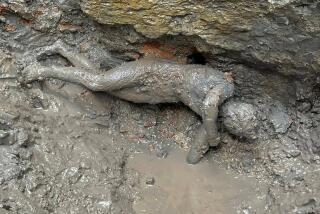Ancient Art Shows Early Man’s Skill
- Share via
Tiny ivory figurines recently discovered in the Swabian Mountains of Germany suggest that the first modern humans to make their way to Europe were “astonishingly precocious artists,” researchers said Thursday.
The three figurines -- a horse’s head, a half man-half lion and a mallard-like bird diving into water -- were discovered by archeologist Nicholas J. Conard of the University of Tubingen at Hohle Fels Cave, about 12 miles southwest of Ulm. The bird is about 2 inches long, the others about 1 inch.
Radiocarbon dating indicates that the figurines are between 32,000 and 34,000 years old, making them the earliest known examples of figurative art -- art that represents human or animal forms. No skeletons were found in the cave near the objects, but other artifacts suggest that they were made by humans, , Conard said. He reported the discovery in the Dec. 18 issue of Nature.
But the figurines “are not ‘art’ as we know it today,” archeologist Anthony Sinclair of the University of Liverpool wrote in an editorial in the same journal. Their surfaces appear to be highly polished from constant handling, indicating that they were not objects meant to be displayed, but rather tokens to be carried around and handled. They may have been teaching aids or toys for children, Sinclair said.
The figurines are roughly contemporaneous with wall paintings found in the 1990s at the Grotte Chauvet in France. The new discoveries suggest “an early migration of modern humans along the Danube Corridor,” Conard wrote.
More to Read
Sign up for Essential California
The most important California stories and recommendations in your inbox every morning.
You may occasionally receive promotional content from the Los Angeles Times.









